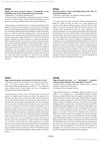Search
for
Sort by
Research
30 / 163 results
research Electron Microscope Studies of Hair and Wool
Hair and wool have complex microscopic structures with microfibrils and varying cystine content.

research Changes of Curvature with Regain of Set Wool and Hair Fibers
Merino wool fibers change shape with moisture, while human hair shape stays the same.

research Morphology and Ultrastructure of Antler Velvet Hair and Body Hair from Red Deer (Cervus elaphus)
Antler velvet hair and body hair of red deer have different structures that help with protection and insulation.

research Stiffness of Human Hair Correlates with the Fractions of Cortical Cell Types
Hair stiffness is higher when it has more para-like cortical cells.

research From Hair Color to Diagnosis
Hair color is influenced by genetics and can indicate certain health conditions.

research A Modular Modeling Approach for Investigating Wool Critical Buckling from Biologically Variable Along-Fiber Microstructure
The model helps understand how wool fiber structure affects its strength and flexibility.

research Biology of the Wool Follicle: An Excursion into a Unique Tissue Interaction System Waiting to Be Rediscovered
The article concludes that the wool follicle is a valuable model for studying tissue interactions and has potential for genetic improvements in wool production.

research Characterization of a Cluster of Human High/Ultrahigh Sulfur Keratin-Associated Protein Genes Embedded in the Type I Keratin Gene Domain on Chromosome 17q12-21
A cluster of sulfur-rich hair protein genes was found on chromosome 17.

research The Cytology and Cytochemistry of the Wool Follicle
Wool follicles are complex, involving interactions between different cell types and structures.

research Organization and Expression of Hair Follicle Genes
Hair growth is controlled by specific gene clusters and proteins, and cysteine affects hair gene expression in sheep.

research The Biology of Hair Care
Better hair care products are needed to protect against grooming and chemical damage.

research Influence of Feed Restriction on the Wool Proteome: A Combined iTRAQ and Fiber Structural Study
Feed restriction in sheep leads to finer wool fibers but may reduce wool quality.

research The Structure of the Amorphous Matrix of Keratins
Human hair keratin fibers have a detailed nano-scale structure that changes with different conditions.

research Chapter 4: Cytomechanics of Hair
Hair's strength and flexibility come from its protein structure and molecular interactions.

research Unruly Hair
The document concludes that unruly hair can be congenital or acquired, often lacks specific treatments, and can be managed with oils and short hairstyles.

research Abnormal Wool Growth and Alopecia of Artificially Reared Lambs
Lambs fed a liquid diet showed abnormal wool and skin, which improved with more B-vitamins, suggesting a link to B-vitamin deficiency.

research How Different Is Human Hair? A Critical Appraisal of Global Hair Fibre Characteristics and Properties Towards Defining a More Relevant Framework for Hair Type Classification
Human hair varies widely and should be classified by curl type rather than race.

research Expression Analysis of the Type I Keratin Protein Keratin 33A in Goat Coat Hair
Keratin 33A is a key protein in goat winter coats, especially in high-producing breeds.

research Lymphatic Vessel: Origin, Heterogeneity, Biological Functions, and Therapeutic Targets
Lymphatic vessels are essential for health and can be targeted to treat various diseases.

research A Review on Forensic Toxicological Analysis of Drugs in Hair Using Various Instrumental Techniques
Hair analysis is better than urine and blood for detecting past drug use.

research Treatment of Pseudofolliculitis Barbae
Combining proper shaving, topical treatments, and laser therapy effectively reduces Pseudofolliculitis Barbae.

research Hair Today, Gone Tomorrow: The Degradation and Conservation of Archaeological Hair Fibers
Acidic sandy clay damages archaeological hair the most, while dry conditions preserve but make it brittle; silicone oil can help keep the hair flexible.

research Structural Analysis of Curly and Straight Human Hair Fibers by Scanning Microbeam SAXS
Curly and straight hair differ in how their internal fibers are arranged.

research Australian Hair and Wool Research Society Cutaneous Biology and Endocrinology Workshop
The workshop highlighted the genetic links and psychological impacts of hair loss and skin disorders.

research Healthy Hair: Form and Function
Hair health is influenced by genetics, aging, and environmental factors, with proper care needed to maintain it.
research Wool Fiber Curvature Is Correlated With Abundance of K38 and Specific Keratin-Associated Proteins
Wool fiber curliness is linked to the presence of certain proteins and K38.
research Identification of Llama KRTAP7-1 and KRTAP8-1 Fiber Genes and Polymorphism Screening
Mutations in specific llama genes may affect fiber quality for textiles.
research Biochemical Evidence That Small Proline-Rich Proteins and Trichohyalin Function in Epithelia by Modulation of the Biomechanical Properties of Their Cornified Cell Envelopes
Small proline-rich proteins and trichohyalin help make epithelial tissues tougher and more flexible.
research Wool Keratin-Associated Protein Genes in Sheep: A Review
Understanding wool keratin-associated proteins in sheep can help improve wool quality through selective breeding.